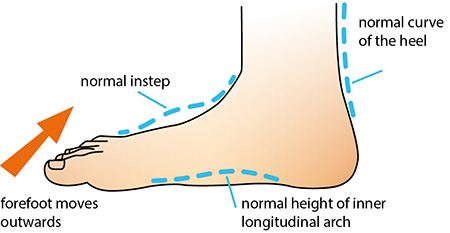back to overview
Skewed flatfoot Corrective socks
Causes

Skewed flatfoot is one of the most common defective foot positions. It is characterised by bending of the heel and flattening of the inner longitudinal arch. This causes the forefoot to move outwards and no longer lie in the direction of movement. This can lead to further problems in the knee and hip area.
The causes of skewed flatfoot include lack of mobility, weak muscles, overstretched ligaments and a lack of muscular control. Additional factors include excess weight and heavy strain through long periods of standing or walking combined with sub-optimal footwear. All this leads to the foot losing its three-dimensional stability.
The causes of skewed flatfoot include lack of mobility, weak muscles, overstretched ligaments and a lack of muscular control. Additional factors include excess weight and heavy strain through long periods of standing or walking combined with sub-optimal footwear. All this leads to the foot losing its three-dimensional stability.
The advantages at a glance

- Wearing time = therapy time
- The socks can be worn inside all shoes
- No irritation of the skin in comparison to taping
- Preventive and therapeutic use
- Works using tension, not pressure
- Three-dimensional stabilisation of the foot
- Use with most foot problems
Skewed flatfoot therapy with corrective socks

Skewed flatfoot therapy socks, which are produced according to the latest biomechanical research and with state-of-the-art manufacturing technology, provide the foot with effective support and have a positive corrective effect on the gait. The built-in taping bands support orientation of the heel bone while also helping to bring the balls of the big toes to the ground more effectively. In the process, continuation of the defective position is reduced and painful overloading of the foot is minimised.
The skewed flatfoot therapy socks can be used preventively or therapeutically. Preventively, they support active stabilisation of the foot, primarily when under increased strain or progressive fatigue. Therapeutically, they orient the hindfoot, relieving overstretched ligaments and supporting weak muscles.
The skewed flatfoot therapy socks can be used preventively or therapeutically. Preventively, they support active stabilisation of the foot, primarily when under increased strain or progressive fatigue. Therapeutically, they orient the hindfoot, relieving overstretched ligaments and supporting weak muscles.
Instructions for use of the skewed flatfoot corrective socks

How do I put the taping socks on correctly?
Please make sure you use the correct sock for the right and left foot. The ‘Taping-Socks’ lettering must always be legible on the outer side of the foot.
The taping bands are divided into two function areas:
the heel and the ball of the foot.
On the outer side, the rear band runs from the base of the Achilles tendon, beneath the outer side of the ankle to the sole of the foot. Its upper edge lightly touches the outer side of the ankle ➊. When pulling the sock on, the band becomes slightly tensioned and thus stabilises the heel in the right position. The front band runs from the sole of the foot at a 45° angle to the ball area at the back of the foot. The front edge sits behind the little toes ➋.
On the inner side, the band also runs from the base of the Achilles tendon, beneath the inner side of the ankle towards the sole of the foot. Here, too, its upper edge lightly touches the inner side of the ankle ➌. The tension of the taping band stabilises the heel in its correct position and the longitudinal arch is raised ➍. The front band holds the first metatarsal towards the ground ➎.
How do I check the positioning is correct?
The lower leg should be vertically aligned to the foot. The correct positioning of the bands is determined using the ‘two finger technique’. For this purpose, the index finger and middle finger are placed around the instep ➏. If the upper edge of the front band is in line with the middle finger, it is correctly positioned ➐.
Please make sure you use the correct sock for the right and left foot. The ‘Taping-Socks’ lettering must always be legible on the outer side of the foot.
The taping bands are divided into two function areas:
the heel and the ball of the foot.
On the outer side, the rear band runs from the base of the Achilles tendon, beneath the outer side of the ankle to the sole of the foot. Its upper edge lightly touches the outer side of the ankle ➊. When pulling the sock on, the band becomes slightly tensioned and thus stabilises the heel in the right position. The front band runs from the sole of the foot at a 45° angle to the ball area at the back of the foot. The front edge sits behind the little toes ➋.
On the inner side, the band also runs from the base of the Achilles tendon, beneath the inner side of the ankle towards the sole of the foot. Here, too, its upper edge lightly touches the inner side of the ankle ➌. The tension of the taping band stabilises the heel in its correct position and the longitudinal arch is raised ➍. The front band holds the first metatarsal towards the ground ➎.
How do I check the positioning is correct?
The lower leg should be vertically aligned to the foot. The correct positioning of the bands is determined using the ‘two finger technique’. For this purpose, the index finger and middle finger are placed around the instep ➏. If the upper edge of the front band is in line with the middle finger, it is correctly positioned ➐.

